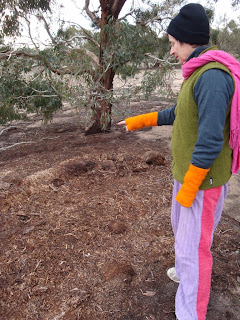This is how you find the already radio-tagged ones. Walk miles through the bush, waving the antenna above your head. Listen for the beeps and follow them. Easy

Amy was confused (me too) when the antennae led us to this open spot. Bandicoot nests are tricky things to find even with the radio signal, but this made no sense. Until we found the shed radio tag, dust covered and ground coloured. Clever bandicoot.
 This is Kellytown...aka the film set for the last? Ned Kelly film. No Kellys here now, only pademelons, bandicoots, kangaroos and wallabies.
This is Kellytown...aka the film set for the last? Ned Kelly film. No Kellys here now, only pademelons, bandicoots, kangaroos and wallabies.
Can you see the nest? It's there...really...where Jackie is pointing..

Can you see it now? Bandicoots make shallow nests, and pull ground litter over them. Even when you know it's there, it's almost impossible to tell. This nest was previously home to one of the tagged bandicoots, but another untagged bandicoot saw the opportunity and made it his own. Bandicoots generally nest only one night in a nest, although they may return sometimes a few days later.

Here was an unexpected opportunity to tag another bandicoot. First to catch him...

Then to weigh him...

Then to tag. These radio tags weigh only a few grams and are attached to the bandicoots tail. Although the tags will transmit for several months, the bandicoots seldom retain them for more than a few weeks.

Then you let him go.
The bandicoots don't seem to mind being handled, leading to one suggestion that promoting them as pets might be one way to help avoid extinction. Not sure how interactive they'd be as pets...they sleep all day and eat all night...
 After release, we mapped out the immediate habitat. That included measuring 10 m from the nest north, south east and west,
After release, we mapped out the immediate habitat. That included measuring 10 m from the nest north, south east and west, using a penetrometer to measure ground hardness, looking at how visible the nest is, ground cover and more.
using a penetrometer to measure ground hardness, looking at how visible the nest is, ground cover and more.It was an amazing thing to see and even handle these tiny shy creatures, but also an education to see just how a recovery program works.
No comments:
Post a Comment